As you saw on the previous posts (put link to post2 and 3), all agricultural activities need air, water, soil and biodiversity, and therefore have an impact on the planet. This impact can be positive if agriculture respects the ecosystem or negative if natural resources are exploited excessively. Agriculture, climate change and food security are interconnected.1 Let’s see how!
The temperature increases
The Earth’s climate changes constantly due to small variations in the planet’s orbit. However, since the end of the 19th century the surface temperature has increased by 0.85 °C (0.65 to 1.06 °C) and the sea level has risen, as shown in the figures below (figure taken from the IPCC 2014 report):2
Human activity and the impact on climate change
This increase is driven in large part by human activities. Humans have altered the delicate balance of the planet by polluting air, water, soil and destroying biodiversity. The figure below (figure taken from the IPCC 2014 report)2 helps us to understand the human impact (anthropogenic) on the atmospheric concentration of greenhouse gases (GHG):
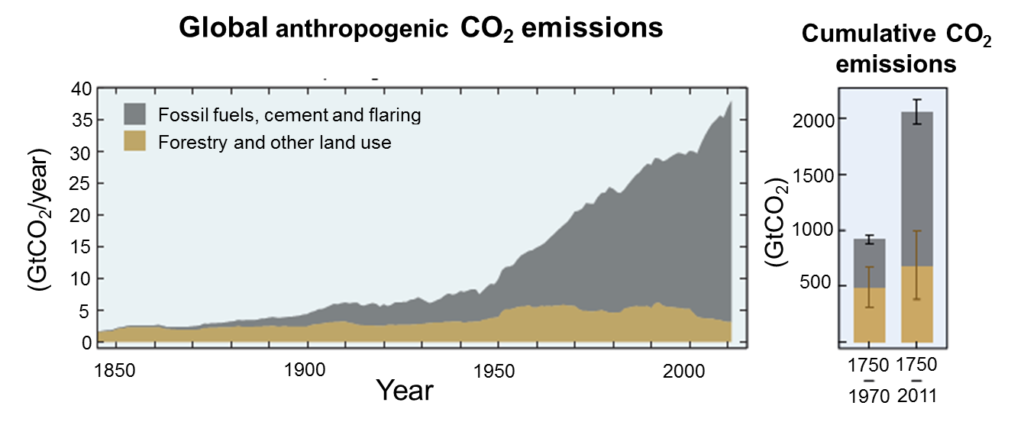
GtCO2 (Gigatonne)= 1 000 000 000 tonnes CO2= 1000 000 000 000 Kg CO2
Source: http://www.ipcc.ch/pdf/assessment-report/ar5/syr/AR5_SYR_FINAL_SPM.pdf
In fact, atmospheric concentrations of carbon dioxide (CO2) have increased by more than 1/3 since the beginning of the 19th century.2
As we mentioned in post 3: Carbon footprint of food = Greenhouse gases (GHG) expressed in Kg of CO2 that a product emits throughout its lifetime.
In fact, GHG capture the heat radiated by the sun and heat the earth.3 Just to mention, water vapor (H2O) is an abundant GHG as well.3 However, due to its impact on the climate (through the formation of clouds and precipitation), and its low human impact, we are not going into details about this one.
The following figure shows the sources and concentration of GHG in the atmosphere.
Believe me, this is really interesting:
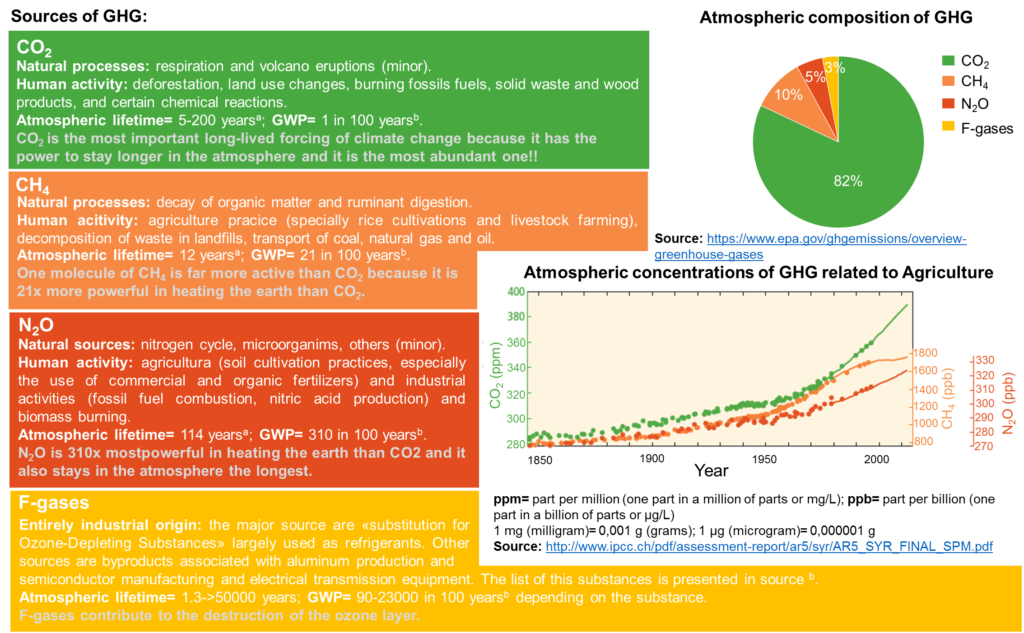
Source: https://www.epa.gov/ghgemissions/overview-greenhouse-gases; https://climate.nasa.gov/causes/
a https://www.ipcc.ch/ipccreports/tar/wg1/016.htm
b https://www.ipcc.ch/publications_and_data/ar4/wg1/en/ch2s2-10-2.html
Global
warming is happening due to an increased emission of GHG, especially caused by
human activity (fossil fuels, industrial processes, increased use of natural
resources, intensive agriculture, livestock farming and deforestation).
FAO (Food and Agriculture Organization of the United Nations) estimates that between the years of 2003 and 2013, natural disasters triggered by natural hazards caused economic losses valued in 1.5 trillion US dollars. In developing countries, during the same time period, these disasters cost about 550 billion US dollars, affecting 2 billion people. About 22% of these damages belong to agriculture and its subsectors (crops, livestock, fisheries and forestry).4
The climate change and the agriculture
Climate change not only causes economic losses, but also has direct and indirect effects on agricultural productivity, such as variations in rainfall regimes, droughts, floods, geographic redistribution of biodiversity (including pests)5 and diseases.1 The large amounts of CO2 absorbed by the oceans also cause acidification which results in deteriorating marine ecosystems.6
One of the biggest consequences of climate change are the natural disasters that are responsible for agricultural losses which have alarming effects on food security.1
So what happens to the earth?
Our planet, the Earth, is overweight (403 ppm CO2 eq. (average value of year 2016)) and increasing.7 Depending on the actions we take, scientists predict that the temperature will rise up to 4 °C by the year 2100 (450 ppm CO2 eq. will increase the planet’s temperature 2 °C and 1000 ppm CO2 eq. 4 °C).2 This means not only an increase in the number of natural disasters but, as the planet gets hotter, it will be very difficult to produce food in the tropics, which will cause biodiversity to migrate (including people) to more peripheral regions in the planet, and as a consequence will result in a tremendous impact on human well-being.5
It is evident that the impact of climate change on food and agriculture is interconnected with environmental, social and economic fields (i.e. food security, nutrition, health, and human migration).1
This is a very serious problem! So, what can we do, and how does it relate to food? To answer these questions, let’s have a close look at the human contribution (our contribution) to the GHG emissions.
Human sources of GHG
The following figure shows the anthropogenic sources of GHG:
We can see that “Energy Production” is by far the biggest source of GHG, but let’s have a look at the second one, “Agricultural Processes” which accounts for 21% of the GHG emitted.1
GHG coming from Agriculture
The following figure shows the share of agricultural emissions in CO2 eq. in year 2014 by source and at a global level:1
The main cause of agricultural GHG emissions is by far enteric fermentation (the digestion processes of ruminants such as cattle, sheep, goats, buffalo, deer, giraffes and camels).
Enteric fermentation is the main source in Latin America and the Caribbean with 58% (followed by manure left on pasture with 23% and synthetic fertilizers with 6%), in Southern Asia with 46%, in Sub-Saharan Africa with 40%, in Northern Africa and Western Asia with 39% and in developed countries with 37%. Only in Oceania (excluding Australia and New Zealand) and in Eastern and Southeastern Asia is the main source of agricultural GHG derived from the cultivation of organic soils with 59% (followed by enteric fermentation with 14% and manure management with 14%) and rice cultivation with 26% (followed by enteric fermentation with 24% and synthetic fertilizer with 17%), respectively.1
But let’s not mistake the problem. Because cows alone are not. They actually contribute to soil fertility inside an healthy ecosystem. The problem is the number cows being raised to meet human demand.
A recent scientific study has quantified the mass of life on earth (biomass) and has shown that within the animal kingdom (2% of the entire biomass), there are more than 10x more humans than wild animals and that there are about 40% more livestock than humans.8 This is crazy!
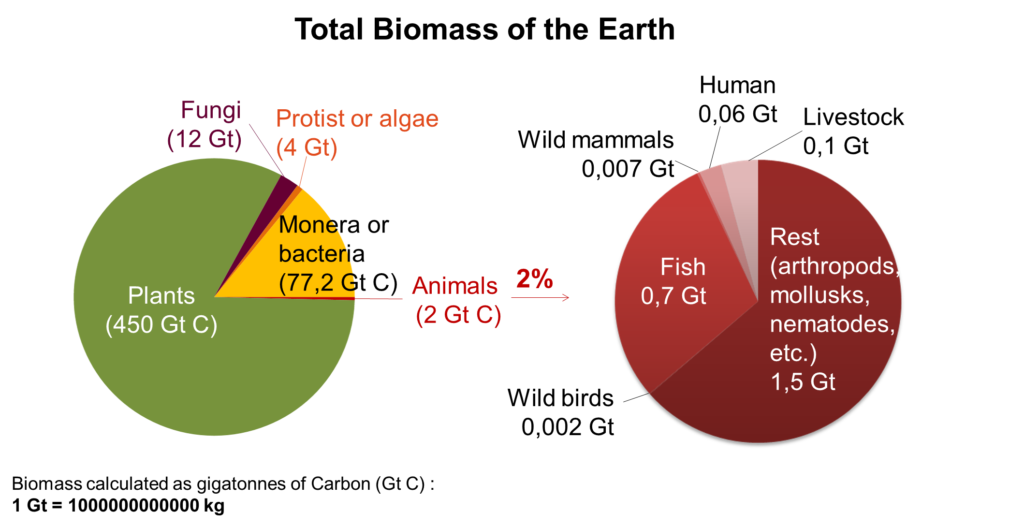
To keep producing meat and to satisfy the world’s food and energy demand of the growing population, the most important forests and savannas will need to be destroyed!1 And if deforestation takes place, what will happen? What is already happening?
Deforestation, Climate Change and the Carbon Cycle
To understand the important role of forests in the weather, we need to talk about the carbon cycle. But let’s start by linking some concepts. Remember CO2 and CH4, our very important GHG, both contain one atom of carbon (C).
However, C is not only found in the atmosphere. Actually, there are five global C pools (as shown in the following figure too):9
- the oceanic pool;
- the geological pool (which includes the fossil fuels);
- the soil pool (comprising the soil organic C and the soil inorganic C);
- the atmospheric pool and;
- the biotic pool (comprising live biomass and detritus material)
There is a strong interaction between the terrestrial and atmospheric C pools through photosynthesis, respiration and soil metabolism. The potential of a healthy soil becomes evident in sequestering atmospheric CO2 in both the biotic and pedologic C pools (620 and 2500 Pg, respectively). Additionally, deforestation impoverishes the soil releasing ca. 1.6 Pg C/Year.9
So, YES, forests are very important, not only because they produce oxygen, but especially because of their capacity to keep a healthy soil which allows the capture of atmospheric CO2.
The ecofriendly agriculture
But we need food, right? Luckily, we can also have a healthy soil through ecofriendly agriculture. Many scientists, farmers and international organizations believe that the understanding of the soil’s role in climate stability and agricultural productivity will trigger the abandonment of conventional practices (i.e. tillage, crop residue removal, mono-cropping, excessive grazing and excessive use of chemical fertilizers and pesticides) and adoption of organic agriculture.
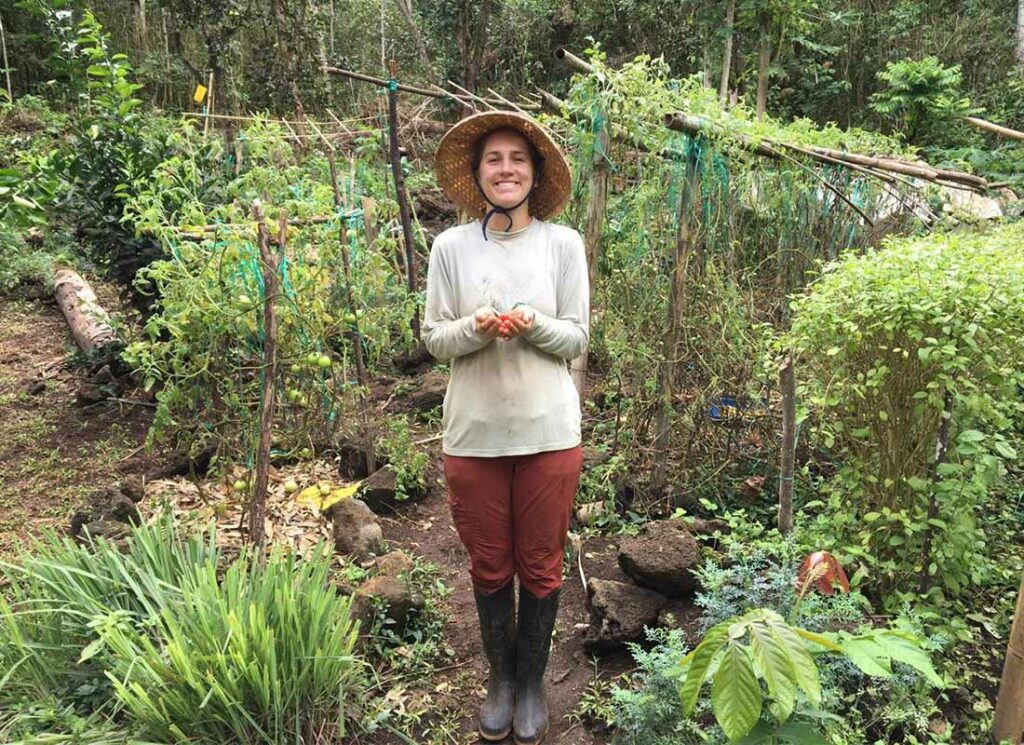
The Potential of Carbon Sequestration through Organic Agriculture
According to FAO: “Organic Agriculture is a holistic production management system which promotes and enhances agro-ecosystem health, including biodiversity, biological cycles, and soil biological activity.”10
Also referred as Agroecology, it is based on applying ecological concepts and principles to optimize interactions between plants, animals, humans and the environment while taking into consideration the social aspects that need to be addressed for a sustainable and fair food system.11
This sustainable form of agriculture takes care of the whole ecosystem! Isn’t it great?
Some sustainable agricultural practices (management practices) that contribute to CO2 sequestration are:9
- reduction/elimination of mechanical tillage;
- application of cover crops into the rotation cycle;
- increasing soil fertility through biological means (i.e. compost, animal manures and nitrogen fixation plants that also contribute to mitigate N2O);
- adoption of conservation-effective measures to minimize soil and water losses (e.g. soil water storage, drip irrigation);
- a better use of the complex farming systems including complex rotations, mixed farming (i.e. crop-livestock) and agroforestry techniques that efficiently use resources, enhance biodiversity and mimic natural ecosystems.
So much information… What can we do now??
Climate change is a big problem which concerns all of us. Choose walking, riding a bike or public transportation instead of driving; heat and cool only the necessary; reevaluate, reconceptualize, restructure, redistribute, relocate, reduce, reuse and recycle.
Regarding food, let’s start by making connections. Food is directly linked with the farmers, the land, the watersheds and the climate. And our health is a reflection of the quality and quantity of the food we consume. At the end, it is all interconnected!
If we reduce waste, change our diet to eat less meat and dairy, support agroecology, local markets and sustainable intensification to increase yields on underperforming crops, and protect the forest, we may be able stop global warming and feed more than nine billion people a healthy diet.
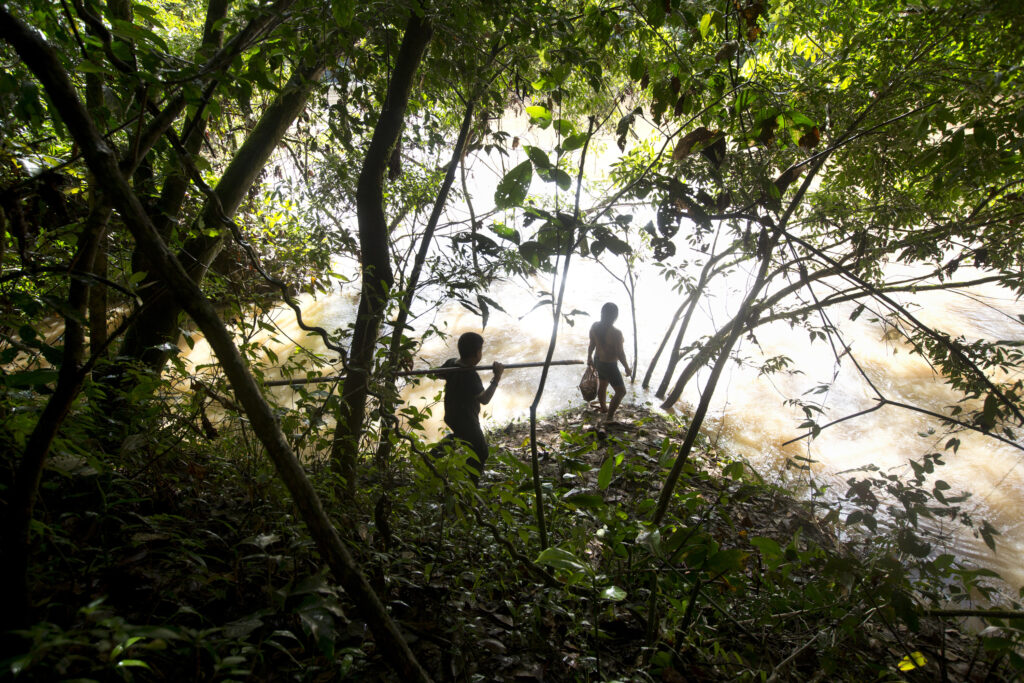
Let’s save the forest, promote and support Organic Agriculture and local markets!
Some great initiatives out there are making a huge difference to help spread good agricultural practices. Organizations like A Growing Culture are promoting and facilitating collective learning between farmers, empowering smaller farmers, supporting agroecological innovations and a sustainable food system.
Another great one is the Godan that shares agricultural and nutritional data globally encouraging collaboration and cooperation that will bring together stakeholders to solve long-standing global problems.
The Equator Initiative on the other hand, recognizes outstanding local sustainable development solutions supporting the formation of resilient communities. The projects being awarded are doing amazing things, it is really worth getting to know them!
An interesting website with more information about food and climate change is the Food Climate Research Network who is raising awareness and connecting stakeholders with the common interest of understanding and building sustainable food systems.
In Drawdown and ZERI, you can find sustainable practices that are already being implemented and; the Ellen Macarthur Report circular solutions that can change the food system within cities. Worth knowing them!
Importantly, children are also actively involved. Fridays for future, the movement started by Greta Thunberg, a Swedish high school student who in August 2018, started school strikes on Fridays asking her government (and later the world), to take political actions to reduce emissions caused by climate change in accordance with the Paris Agreement. The movement has expand and is now present in 101 countries around the world.
Juliana versus USA, is a lawsuit filed in 2015 by 21 young plaintiffs asserting that the federal government violated their constitutional rights to life, liberty and prosperity (only possible inside a clean environment) by causing dangerous carbon dioxide concentrations. Let’s stay tuned and see how this demand develops.
Another very interesting case is the lawsuit known as “The Huaraz Case”. In 2015, Saúl Luciano Lliuya, a mountain guide living in Huaraz, Peru, filed a lawsuit against the German energy company RWE to be responsible for its carbon emissions. The global increase in carbon in the atmosphere is causing the melting of the Peruvian glacial risking to destroy the home of his community. He asks for the construction of a dam to protect his home for the future effects of climate change.
A proposal worth mentioning is the Yasuní-ITT Initiative in which the government of Ecuador proposed to the world in 2010, to maintain the oil reserves that are located below one of the regions with the greatest biodiversity in the world, Yasuni National Park in the Ecuadorian Amazon, in exchange for the potential oil revenues (3.6 billion US dollars). The objective of the initiative was to conserve biodiversity, protect indigenous peoples living in voluntary isolation and avoid CO2 emissions. Unfortunately, fundraising was insufficient and oil has been extracted since 2016.
Ecuador has also been a pioneer in the protection of nature at the political level, being the first country in the world where “Nature is a subject of law”, meaning that the Ecuadorian Constitution (or Montecristi Constitution) recognizes since 2008 the right to life of species beyond utility or affectation for humans. It protects life reproduction, both in the ecological and evolutionary sense claiming the right to integral restoration. It also recognizes that the rights of people and nature complement and enhance each other, and that in nature there are no geographical barriers. The constitutions, however, does not oblige to have an untouched nature or animal welfare, allowing large-scale mining even in fragile areas among other economic activities that destroy nature. Undoubtedly, a lot of work still needs to be done…
Recently, an important philosophical claim to respect nature has also come from the Vatican with the encyclical Laudato si’ written by Pope Francis. The document emphasizes the fact that the human being is not the owner of nature, but only a part of it, which depends on it to exist and exalts the human duty to preserve it. It is worth reading!
Supporting existing and outstanding initiatives that are working to solve the problem is of course important. However, each one of us can be part of the solution by properly choosing our food, what and where we are buying, from whom we are buying and at what price. These little gestures can really start changing the world!
By M. S. Gachet et N. Zanuto
REFERENCES:
1 FAO, 2016: The State of Food and Agriculture. Climate change, Agriculture and Food Security.
2 IPCC, 2014. Climate Change 2014: Synthesis Report. Contribution of Working Groups I, II and III to the Fifth Assessment Report of the Intergovernmental Panel on Climate Change [Core Writing Team, R.K. Pachauri and L.A. Meyer (eds.)]. IPCC, Geneva, Switzerland, 151 pp.
3 NASA. The Causes of Climate Change.
4 FAO, 2015: The impact of disasters on agriculture and food security.
5 Pecl, G.T, et al. Biodiversity redistribution under climate change: Impacts on ecosystems and human well-being. Science (2017) 355(6332).
6 FAO, 2010: Environmental consequences of oceans acidification: a threat to food security.
7 Dlugokencky, E. Annual Mean Carbon Dioxide Data. Earth System Research Laboratory. National Oceanic & Atmospheric Administration.
8 Nar-On, Y.M., et al. The biomass distribution on Earth.
9 Solaw-FAO. Report 4B – Soil carbon sequestration. Lal R.
10 FAO. Organic Agriculture.
11 FAO. Agroecology Knowledge Hub.

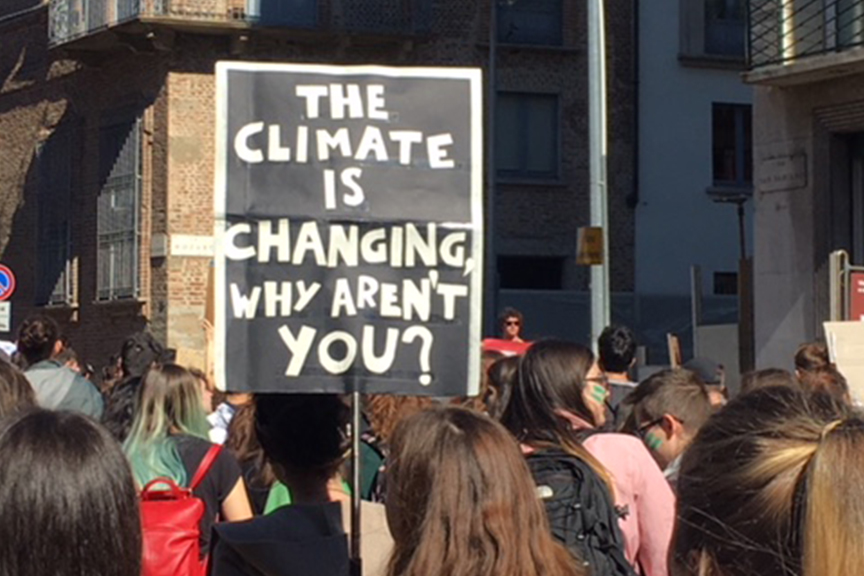



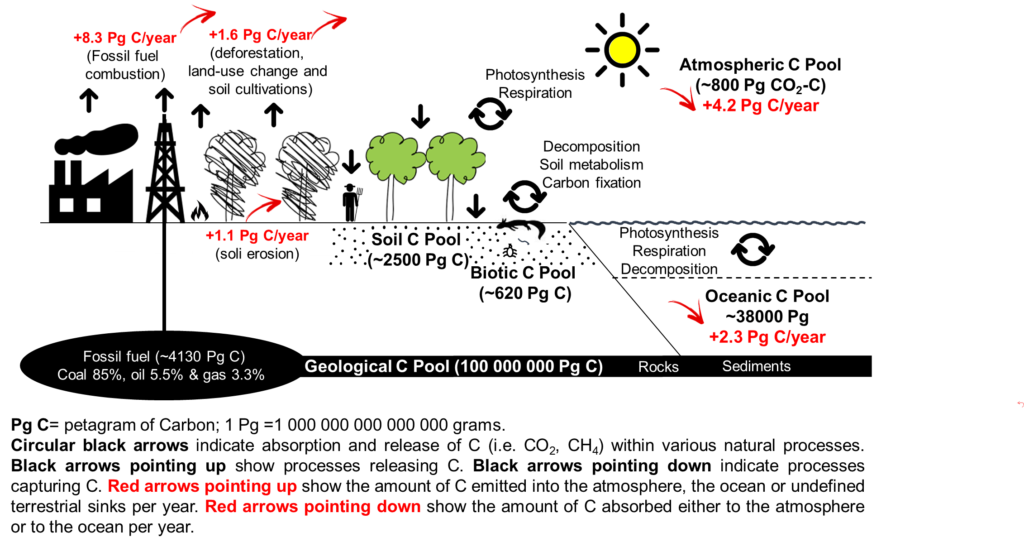
Good blog! I truly love how it is simple on my eyes and the data are well written. I’m wondering how I might be notified whenever a new post has been made. I’ve subscribed to your RSS feed which must do the trick! Have a great day!
This constantly amazes me exactly how bloggers such as yourself can find some time and also the dedication to carry on creating good blogposts. Your blog isgood and one of my own must read weblogs. I just wanted to thank you.
This is a really great blog your have here but I had some questions about advertising on your site. So if you could reply to this post with a contact email, that would be great.
Hello ..I really liked your post , but just to inform you that there are some broken links in some of your old posts , use some of tools online to check and correct this links or you can use this tool , it is very effective and they offer free trial https://dc189.isrefer.com/go/home/payblogg/ hope that can help you to improve your blog posts keep writing the great stuff .
An impressive share! I’ve just forwarded this onto a co-worker who has been doing a little research on this. And he actually bought me dinner due to the fact that I found it for him… lol. So allow me to reword this…. Thank YOU for the meal!! But yeah, thanx for spending time to talk about this topic here on your website.
Hello, if you are interested in receiving our latest publications we invite you to subscribe to our newsletter (white envelope followed by the word SUBSCRIBE in the upper right corner of our website) 🙂
I simply want to mention I’m beginner to blogs and honestly liked your blog. More than likely I’m planning to bookmark your website . You actually come with fantastic stories. Thanks a lot for sharing your website page.
Hello, if you are interested in receiving our latest publications we invite you to subscribe to our newsletter (white envelope followed by the word SUBSCRIBE in the upper right corner of our website) 🙂
A fascinating conversation is worth remark. I think that you must create a lot more on this subject, it may not be a frowned on subject however typically individuals are not nearly enough to talk on such topics. To the next. Thanks
Hello, if you are interested in receiving our latest publications we invite you to subscribe to our newsletter (white envelope followed by the word SUBSCRIBE in the upper right corner of our website) 🙂
Perfect work you have done, this site is really cool with good information.
Hello, if you are interested in receiving our latest publications we invite you to subscribe to our newsletter (white envelope followed by the word SUBSCRIBE in the upper right corner of our website) 🙂
Hello just wanted to give you a quick heads up. The text in your article seem to be running off the screen in Safari. I’m not sure if this is a format issue or something to do with browser compatibility but I figured I’d post to let you know. The design look great though! Hope you get the problem fixed soon. Cheers
Thanks!! We will check it out:)
Hello, if you are interested in receiving our latest publications we invite you to subscribe to our newsletter (white envelope followed by the word SUBSCRIBE in the upper right corner of our website) 🙂
Have you ever thought about including a little bit more than just your articles? I mean, what you say is valuable and all. But imagine if you added some great graphics or video clips to give your posts more, “pop”! Your content is excellent but with pics and video clips, this website could definitely be one of the very best in its niche. Superb blog!
Hello, if you are interested in receiving our latest publications we invite you to subscribe to our newsletter (white envelope followed by the word SUBSCRIBE in the upper right corner of our website) 🙂
After research study a few of the post on your internet site currently, and I really like your means of blogging. I bookmarked it to my book marking internet site checklist and will certainly be inspecting back quickly. Pls take a look at my website too and also let me recognize what you believe.
Hello, if you are interested in receiving our latest publications we invite you to subscribe to our newsletter (white envelope followed by the word SUBSCRIBE in the upper right corner of our website) 🙂
I loved your article post.Really thank you! Want more.
Hello and thanks for your comment:) If you are interested in receiving our latest publications we invite you to subscribe to our newsletter (white envelope followed by the word SUBSCRIBE in the upper right corner of our website) 🙂
Wonderful article! We are linking to this great content on our website. Keep up the good writing.
Hello and thanks for your comment:) If you are interested in receiving our latest publications we invite you to subscribe to our newsletter (white envelope followed by the word SUBSCRIBE in the upper right corner of our website) 🙂
I could not resist commenting. Well written!
Hello and thanks for your comment:) If you are interested in receiving our latest publications we invite you to subscribe to our newsletter (white envelope followed by the word SUBSCRIBE in the upper right corner of our website) 🙂
Hello there! I could have sworn I’ve been to this web site before but after going through a few of the posts I realized it’s new to me. Regardless, I’m definitely delighted I came across it and I’ll be book-marking it and checking back regularly!
Hello and thanks for your interest:) If you are interested in receiving our latest publications we invite you to subscribe to our newsletter (white envelope followed by the word SUBSCRIBE in the upper right corner of our website) 🙂
I’m very pleased to discover this page. I need to to thank you for ones time due to this wonderful read!! I definitely really liked every bit of it and I have you saved as a favorite to look at new stuff in your website.
Hello and thanks for your comment:) If you are interested in receiving our latest publications we invite you to subscribe to our newsletter (white envelope followed by the word SUBSCRIBE in the upper right corner of our website) 🙂
Excellent blog post. I certainly love this website. Stick with it!
Hello and thanks for your comment:) If you are interested in receiving our latest publications we invite you to subscribe to our newsletter (white envelope followed by the word SUBSCRIBE in the upper right corner of our website) 🙂
Howdy! This post couldn’t be written any better! Reading through this post reminds me of my previous roommate! He always kept talking about this. I am going to forward this article to him. Fairly certain he’s going to have a very good read. Thank you for sharing!
Helloa and thanks for your comment:) If you are interested in receiving our latest publications we invite you to subscribe to our newsletter (white envelope followed by the word SUBSCRIBE in the upper right corner of our website) 🙂
This is a topic that is near to my heart… Best wishes! Where are your contact details though?
Hello and thanks for your comment:) If you are interested in receiving our latest publications we invite you to subscribe to our newsletter (white envelope followed by the word SUBSCRIBE in the upper right corner of our website) 🙂 Contacts can be found in the menu bar at the top of the page.
I must thank you for the efforts you have put in writing this blog. I really hope to see the same high-grade blog posts by you later on as well. In truth, your creative writing abilities has encouraged me to get my own, personal website now 😉
Hello and thanks for your comment:) If you are interested in receiving our latest publications we invite you to subscribe to our newsletter (white envelope followed by the word SUBSCRIBE in the upper right corner of our website) 🙂 Good luck with your webside!
Next time I read a blog, I hope that it doesn’t disappoint me as much as this particular one. After all, Yes, it was my choice to read through, but I actually believed you would probably have something interesting to say. All I hear is a bunch of complaining about something you could fix if you were not too busy seeking attention.
The point is we can all do something:) Good luck.
After I initially left a comment I seem to have clicked on the -Notify me when new comments are added- checkbox and from now on whenever a comment is added I recieve four emails with the same comment. There has to be an easy method you are able to remove me from that service? Kudos!
I will try to fix it, thanks for mentioning it!
I could not refrain from commenting. Very well written!
Everything is very open with a clear explanation of the issues. It was truly informative. Your site is very helpful. Thank you for sharing!
Next time I read a blog, Hopefully it won’t disappoint me just as much as this particular one. I mean, I know it was my choice to read, nonetheless I genuinely believed you’d have something interesting to say. All I hear is a bunch of moaning about something you could possibly fix if you were not too busy looking for attention.
Hi, There’s no doubt that your web site might be having internet browser compatibility issues. When I take a look at your website in Safari, it looks fine however when opening in IE, it’s got some overlapping issues. I just wanted to give you a quick heads up! Apart from that, great website!
Your style is very unique compared to other people I have read stuff from. Many thanks for posting when you have the opportunity, Guess I will just bookmark this site.
Great blog you have got here.. It’s difficult to find good quality writing like yours these days. I truly appreciate people like you! Take care!!
I blog often and I really thank you for your content. This great article has really peaked my interest. I am going to bookmark your website and keep checking for new information about once a week. I subscribed to your Feed as well.
Spot on with this write-up, I truly think this amazing site needs a lot more attention. I’ll probably be returning to read more, thanks for the advice!
I love it when folks come together and share views. Great site, stick with it!
Great site you have here.. It’s hard to find high quality writing like yours these days. I really appreciate people like you! Take care!!
I like looking through an article that will make men and women think. Also, many thanks for allowing me to comment!
Very good article. I’m facing some of these issues as well..
I really love your website.. Pleasant colors & theme. Did you build this web site yourself? Please reply back as I’m looking to create my own website and would love to find out where you got this from or what the theme is called. Thank you!
This is a topic that’s close to my heart… Many thanks! Where are your contact details though?
Everything is very open with a very clear explanation of the challenges. It was definitely informative. Your website is extremely helpful. Thank you for sharing!
An intriguing discussion is worth comment. There’s no doubt that that you need to publish more on this issue, it may not be a taboo subject but generally people don’t discuss such issues. To the next! All the best!!
Greetings! Very useful advice in this particular article! It is the little changes that will make the most important changes. Thanks a lot for sharing!
After I originally commented I seem to have clicked on the -Notify me when new comments are added- checkbox and from now on each time a comment is added I recieve four emails with the same comment. Is there a means you are able to remove me from that service? Thanks!
Good web site you’ve got here.. It’s hard to find high-quality writing like yours nowadays. I truly appreciate individuals like you! Take care!!
That is a really good tip especially to those new to the blogosphere. Simple but very precise information… Thank you for sharing this one. A must read post!
Hi, I do think this is a great site. I stumbledupon it 😉 I’m going to revisit once again since i have saved as a favorite it. Money and freedom is the best way to change, may you be rich and continue to help others.
bookmarked!!, I like your website!
Saved as a favorite, I love your website!
I absolutely love your site.. Excellent colors & theme. Did you build this amazing site yourself? Please reply back as I’m planning to create my very own site and want to learn where you got this from or what the theme is called. Thank you!
This is a great tip especially to those fresh to the blogosphere. Short but very accurate info… Many thanks for sharing this one. A must read article!
Hi there! I just wish to give you a huge thumbs up for the great info you’ve got right here on this post. I am returning to your website for more soon.
An interesting discussion is definitely worth comment. I do believe that you should publish more on this subject matter, it may not be a taboo matter but generally people don’t discuss these subjects. To the next! Many thanks!!
An outstanding share! I have just forwarded this onto a colleague who has been conducting a little research on this. And he actually ordered me lunch simply because I discovered it for him… lol. So let me reword this…. Thank YOU for the meal!! But yeah, thanx for spending the time to discuss this matter here on your site.
An interesting discussion is worth comment. I do believe that you need to write more on this subject matter, it might not be a taboo matter but typically people don’t discuss such topics. To the next! Many thanks!!
Everything is very open with a clear clarification of the issues. It was truly informative. Your website is very helpful. Thanks for sharing!
You need to be a part of a contest for one of the highest quality websites on the internet. I’m going to highly recommend this site!